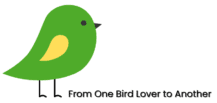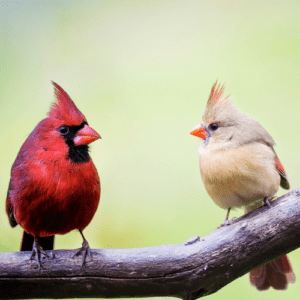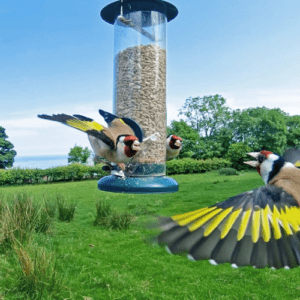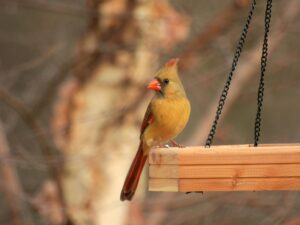- Step 1: Choosing the Right Feeder (Hint: One Is Not Enough!)
- Step 2: Getting the Good Stuff (Birds Are Seed Snobs, Too)
- Step 3: Finding the Perfect Spot (AKA, the Feeder Feng Shui)
- Step 4: Adding Water (The “Secret Sauce” for Bird Attraction)
- Step 5: The Waiting Game (Patience, Grasshopper)
- Step 6: Cleanliness Counts (Yes, Even for Birds)
- Step 7: The Importance of Shelter: Why Your Birds Need a Safe Space
- Troubleshooting How to Attract Birds to a Feeder: When Birds Are Being Stubborn
- How to Attract Birds to a Feeder: Creating a Bird Haven Takes Time, But It’s Worth It
How to attract birds to a feeder? If you’ve just set up a bird feeder and are staring out the window, eagerly waiting for that first little visitor, believe me—I’ve been there. I remember putting up my very first feeder, thinking it would instantly become the hottest spot in town. I practically lived by the window, coffee in hand, waiting for even the tiniest flash of feathers. But, here’s the thing: my “bird café” stayed empty. Not a single visitor. I’d stand there, looking at my empty feeder, wondering, “Where are they?”
Turns out, understanding how to attract birds to a feeder isn’t as easy as tossing out a bit of seed and calling it a day. It took patience (a lot of it), some trial and error, and quite a few laughs at my own mistakes. But bit by bit, I figured out what works, and now my yard is full of chirping, flapping, and feathered visitors. So here’s my personal guide about how to attract birds to a feeder —complete with the things that worked and the funny flops that didn’t—to help you create your own bird haven without all the guesswork.
Step 1: Choosing the Right Feeder (Hint: One Is Not Enough!)
At first, I went for the most basic bird feeder I could find, thinking, “It’s just a feeder—how complicated could it be?” I imagined birds flocking instantly, eager for a free meal. But reality check: the birds thought otherwise. Day after day, I found myself sitting by the window, staring at my feeder like it was a birdless ghost town. I was seriously starting to question my bird-hosting skills.
After a few too many quiet mornings, I realized birds are actually quite selective about where they dine. Each species has its own specific “feeder style,” and it’s not just about food—it’s about ambiance! Once I set up a variety of feeders, I felt like I was curating a custom bird menu, as if my yard had turned into an exclusive bird bistro. What surprised me was how quickly each feeder attracted its own little crowd, and I learned that different feeders are like different dining experiences for birds—each with its own “regulars” who keep coming back. Here’s what I found actually works best for each bird type:
Research Insight: Many different studies have demonstrated certain feeding behaviors of birds, based on their anatomical structure and foraging behaviors. Small songbirds, such as chickadees and finches, frequent tube feeders since they can sit and feed comfortably without being disturbed by larger species. Woodpeckers, with their strong beaks, would prefer suet since this would give them a fat- and protein-rich food source, especially during the colder months of the year (Vanderwerf, 2007).
Tube Feeders: These are like cozy little cafés for small songbirds—finches, chickadees, titmice, and sparrows love them. I’d watch as they perched on the tiny feeding ports, happily munching away. With multiple perches along the cylinder, they get to eat in peace, without larger birds or squirrels bothering them. It’s the perfect setup for these small birds to hang out without much interruption.
Platform Feeders: Think of these as the food courts of the bird world. Doves, juncos, sparrows, and cardinals all seem to enjoy the space these feeders provide. The flat surface lets them move around and pick at seeds at their leisure. I love watching the cardinals here; they’re a little shy, so it gives them plenty of room to feel comfortable. Just a heads-up, though—squirrels love these open spaces too, so they’re likely to show up uninvited from time to time!
Suet Feeders: The wintertime favorite! Woodpeckers, nuthatches, and even chickadees go crazy for suet. I’d watch woodpeckers clinging to the feeder, hammering away at the suet as if it were their favorite snack bar. In colder months, I noticed more visitors to the suet feeder, which makes sense since they need those high-calorie bites to stay warm and energized.
Nyjer (Thistle) Feeders: If you want to attract goldfinches, pine siskins, and redpolls, you need a nyjer feeder. I call it my “finch magnet.” The feeder has these tiny slit-like openings that prevent the lightweight seeds from spilling out, and finches just love them. Goldfinches, with their bright yellow feathers, flock to it like it’s a VIP bar. There’s something so calming about watching them feed on nyjer seeds.
Hopper Feeders: These feeders are the all-purpose diners of the bird world. Shaped like little birdhouses, they attract a whole range of birds—cardinals, blue jays, and grosbeaks all seem to make regular appearances. They offer some shelter for the seed, which means less waste and fewer spills. I especially love seeing blue jays here; they’re a bit loud, but they have this bold, charming way of swooping in like they own the place.
Setting up this “bird buffet” has completely changed my yard. Now I know that each feeder attracts its own feathered fanbase, and it’s like hosting a little bird festival each day. From tiny finches to colorful cardinals and bold blue jays, each species brings its own personality to the feeders. It’s been such a rewarding experience, and it just goes to show that when it comes to feeding birds, one size definitely doesn’t fit all!
So, after my “bird buffet” was complete—tube feeders, platform feeders, suet, hopper feeders, and a nectar feeder—I finally had a bustling birdie hotspot. Each bird found its perfect place, and watching the variety of feeding habits was a show in itself. I learned that for birds, a feeder isn’t just a source of food; it’s a dining experience that has to meet their specific needs. If you’re wondering why your feeder is empty, try setting up a variety pack. Your backyard might just turn into the most popular bird café on the block!
My Lesson Learned: More feeders = more birds. It was like adding VIP seating at a concert, and suddenly, I had chickadees, finches, and sparrows all at once. I felt like I’d opened the most exclusive bird café in town!
Step 2: Getting the Good Stuff (Birds Are Seed Snobs, Too)
When I first set up my bird feeder, I was in full beginner mode. I grabbed the cheapest, biggest bag of birdseed I could find, tossed it in the feeder, and waited, figuring that birds would flock to it immediately. I mean, it’s just seeds, right? How picky could they be? But day after day, my feeder stayed untouched. I’d catch myself muttering to the empty yard, “What gives, guys? This is a free meal!” But nope—not a single visitor. I was genuinely baffled, and maybe a little insulted, wondering if my local birds were staging a silent protest.
Research Insight: Many researches note that black oil sunflower seeds have been the most popular among a variety of birds. A very good energy source, rich in fat and protein, these seed types are considered to be the best food for birds as they help them pull through cold months. The shells are so easy to crack-open that many birds love this seed, such as chickadees, cardinals, and sparrows. (Kaufman, 2000).
Finally, after some late-night Googling and a few “bird whisperer” YouTube videos, I realized what I’d been missing: birds are picky! That bargain-bin seed mix was full of filler junk like milo and cracked corn, which, as it turns out, most birds won’t touch. I’d basically put out a buffet of birdie rejects. So, I decided to level up my seed game and swapped the cheap stuff for a mix of black oil sunflower seeds, nyjer, and safflower. And wow, talk about a transformation! It was like my yard suddenly became the coolest hangout in town.
The black oil sunflower seeds were an instant hit. Apparently, they’re like the bird equivalent of pizza—everyone loves them. Cardinals, chickadees, and sparrows all seemed to dive in, and they brought their friends, too. It was finally happening! My empty yard started to fill with the chirps and flutters I’d been waiting for. Then, the nyjer seed worked its charm on the finches, especially those bright yellow goldfinches who turned my feeder into a splash of color. I’d never seen goldfinches before, and watching them happily munch away on those tiny nyjer seeds felt like I’d unlocked a secret backyard treasure.
And let’s talk about safflower. This seed was a game-changer for a whole other reason: squirrels. Squirrels had been treating my feeder like their personal snack shack, but as soon as I added safflower, they lost interest. Turns out, cardinals and chickadees love it, but squirrels can’t stand it. Watching the cardinals settle in on the safflower while squirrels sniffed and walked away? That was a victory dance moment for me.
Now, I wouldn’t dream of going back to the cheap stuff. Seeing my yard finally full of birds—flashes of red, yellow, and chirping friends—is worth every penny. And every morning, as I sip my coffee and watch my feathered guests enjoying their “five-star” meal, I can’t help but feel a little proud. Turns out, all they wanted was some quality food—and maybe a little bit of respect for their refined taste!
Tip: Think of birdseed like coffee. If you put out the good stuff, they’ll notice. Quality seed tells the birds your feeder is the place to be—and trust me, they’re happy to spread the word.
My Go-To Seeds: I keep a steady mix of black oil sunflower, safflower, and nyjer in my feeders. I call it the “birdie buffet,” and ever since I made the switch, they just keep coming back for more.
Step 3: Finding the Perfect Spot (AKA, the Feeder Feng Shui)
I learned quickly that birds are all about location. My first feeder was out in the open—easy for me to see, but apparently not ideal for them. Birds like a little privacy and a place to dash for cover if they spot a predator, so I moved my feeders closer to some shrubs. Instantly, it made a difference. Birds like having a bit of “green room” space before and after they eat.
Proximity to Cover: Birds feel safer if they have trees or bushes nearby, so place your feeder within a few feet of cover. It makes them more comfortable, and they’ll stay longer to enjoy their meal.
My Lesson: As soon as I moved the feeder near some bushes, the birds seemed to relax, and I had a full house. It’s like setting up seating by the window in a cozy café—they can dine and dash if they feel the need.
Step 4: Adding Water (The “Secret Sauce” for Bird Attraction)
Adding a birdbath was a total game-changer. I’d been focused on food for so long that I didn’t realize what I was missing. But as soon as I set up that birdbath, it was like my yard transformed into a little bird spa. The very first day, a robin landed, looked around for a second, and then hopped right in. Watching it splash around, fluffing its feathers and practically grinning, was like witnessing pure joy. I couldn’t stop watching—it felt like I’d created this tiny, magical oasis in my own backyard.
Birds need fresh water for both drinking and bathing, and it turns out a birdbath is an irresistible invitation. Not only does the water keep them hydrated, but bathing helps birds keep their feathers in tip-top shape, essential for both insulation and flying. I was amazed at how quickly more birds started showing up just for the water. After a few days, I even noticed that some birds seemed to arrive just for a bath; they’d skip the feeder altogether and head straight for the water. It was like they’d added “morning bath” to their daily routine.

Then I decided to add a small bubbler, just to keep the water moving, and wow—what a difference that made! The sound of moving water draws birds in like a magnet, and the bubbler kept the water cleaner for longer, too. Suddenly, it wasn’t just robins but finches, sparrows, and even a curious cardinal or two, all taking turns splashing, drinking, and sometimes just sitting on the edge, enjoying the scene. The birdbath became a true focal point, and honestly, I think I enjoy watching their bath parties as much as they enjoy taking them. Now, I can’t imagine my bird setup without it—it’s like the heart of my little backyard bird sanctuary.
Tip: Keep the water fresh! Birds prefer clean water, and if you can add a little movement, like a bubbler or dripper, even better. The sound attracts them, and it’s a great addition to your feeder setup.
My Experience: The birdbath is hands-down my backyard MVP. I’ve seen everything from finches to robins taking a dip, and there’s something incredibly entertaining about a birdie bath party.
Step 5: The Waiting Game (Patience, Grasshopper)
If you’re wondering how long before birds come to a new feeder, the answer can be frustratingly slow. Some birds find it within days, while others take a few weeks. I remember checking every morning, feeling a bit defeated every time I saw the feeder was still empty. But then, one morning, there they were—my first visitors. And after that, they kept coming back. It turns out, once birds know a reliable spot, they spread the word quickly.
Tip: Don’t give up! Birds are creatures of habit, and they take time to trust a new food source. Stick with it, and eventually, your feeder will become a regular stop on their route.
My Waiting Game: It took a good two weeks before I saw my first bird. But once it discovered the feeder, it was like an open invitation for all its friends.
Step 6: Cleanliness Counts (Yes, Even for Birds)
I never thought about cleaning the feeder much until I noticed a weird, wet clump of seed after a rainy day. Birds can actually get sick from moldy seeds, so regular cleaning is essential. Now I make it a habit to give my feeders a quick clean every two weeks, and after storms, I check for any soggy seeds. Birds seem to appreciate a fresh setup as much as I do.
Cleaning Tip: Use a mild bleach solution (1 part bleach to 9 parts water), rinse thoroughly, and let it dry completely before refilling. Your feathered friends will appreciate the fresh, clean feeder, and it’ll keep them coming back.
My Routine: Cleaning the feeder turned out to be worth the effort. Now, I feel like a proper host, making sure my bird visitors get the best possible experience!
Step 7: The Importance of Shelter: Why Your Birds Need a Safe Space
As a bird lover who’s been through it all, I can tell you—shelter is just as important as food and water when it comes to how to attract birds to a feeder. I didn’t fully grasp this at first, thinking that the more open the space, the better. But I quickly learned that birds are skittish little creatures who need a safe place to perch and feel secure. I’ve had my fair share of disappointing days when the birds just weren’t coming, and then it clicked—they needed cover.
I remember once when I had the perfect feeder set up, stocked with fresh sunflower seeds, but still, no birds. After watching a neighbor’s cat prowl around my yard, it suddenly made sense. Birds aren’t just there for the food—they need to feel safe. So, I moved my feeder closer to a big bush, hoping it would offer some shelter, and within days, the birds returned. The chickadees, sparrows, and cardinals seemed much more comfortable with that extra layer of protection. They could feed and then retreat to the nearby branches if they sensed danger.
Adding shelter around your feeders—whether it’s a dense shrub, a tree, or even a tall grass clump—gives the birds a place to hide, rest, and feel confident. They won’t stick around for long if they don’t feel safe. So, if you’re struggling to bring birds into your yard, think about how much shelter you’ve provided. It might just be the missing ingredient to turn your feeder into a bustling bird hotspot!
Troubleshooting How to Attract Birds to a Feeder: When Birds Are Being Stubborn
Oh, I’ve been there. I recall the early days of bird feeding like it was yesterday—sitting by the window, coffee in hand, watching a perfectly empty feeder. I was convinced the birds had been given the wrong address, or maybe my yard was simply off the birdie grid. I felt like a failed bird concierge. But after a bit of trial and error (and a few too many hours staring out that window), I figured out what was going on—and I’m here to share what worked for me.
1. Season: Birds are like us—they follow their own schedule. In the warmer months, they’ve got plenty of natural food to feast on. I was getting discouraged at first, wondering why the birds weren’t interested in my perfectly stocked feeder. But then it clicked: as the weather cooled and food got scarcer, the birds came back. Winter, it turns out, is the golden time for bird feeding.
2. Predators: This one hit me hard. A couple of neighborhood cats had made themselves regulars in my yard, and I noticed my bird traffic dropped significantly. Birds, I learned, are skittish little creatures, and if they feel unsafe, they won’t come around. I moved my feeder closer to a tree, and bam—suddenly, my backyard felt like a sanctuary, and the birds returned. Safe space, just like us!
3. Consistency: This was my rookie mistake. I’d fill the feeder, check for birds, and if they didn’t show up within a few hours, I’d let it slide and leave it empty for a while. Big mistake! Birds love routine. Once I got into the habit of keeping the feeder stocked and clean, they started coming around regularly. Birds are creatures of habit, and they need to know that food will always be available, no matter what.
My Tip: And then, one particularly quiet winter, I was about to give up. The birds hadn’t visited in days, and I was beginning to feel like I was hosting an empty party. That’s when I decided to mix up my seed blend—more sunflower seeds, suet, and a bit of safflower to keep the squirrels at bay. I thought, “What’s the worst that could happen?” And guess what? Within a few days, my usual crowd showed up. They loved the new selection, and my feeder went from lonely to packed with visitors.
If the birds aren’t showing up right away, don’t lose heart. Keep things consistent, make a few small adjustments, and, most importantly, be patient. Birds are picky, but once they find your feeder, they’ll keep coming back. Believe me, when the first bird lands after a dry spell, it’s like you’ve just won the birdie lottery.
How to Attract Birds to a Feeder: Creating a Bird Haven Takes Time, But It’s Worth It
Setting up a bird feeder can feel like a bit of a waiting game, but trust me, the payoff is so rewarding. Once the birds start coming, it’s like your own little wildlife show every day. Now, my backyard is full of color and song, and there’s something magical about watching all these different species flutter around, finding a spot on the feeder or splashing in the birdbath.
If you’re just getting started, hang in there! Birds can be stubborn, but once they realize your feeder is a safe, quality spot, they’ll keep coming back. And who knows? Before long, you might find yourself setting up a second feeder just to keep up with all the new feathery friends you’ve made. Hope you enjoyed my guide about how to attract birds to a feeder.




